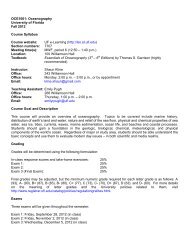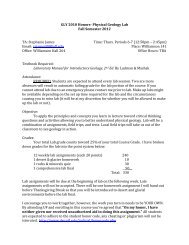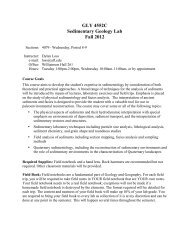Barletta et al 2010.pdf - Department of Geological Sciences ...
Barletta et al 2010.pdf - Department of Geological Sciences ...
Barletta et al 2010.pdf - Department of Geological Sciences ...
You also want an ePaper? Increase the reach of your titles
YUMPU automatically turns print PDFs into web optimized ePapers that Google loves.
F. <strong>Barl<strong>et</strong>ta</strong> <strong>et</strong> <strong>al</strong>. / Quaternary Science Reviews 29 (2010) 2315e2324 2323<br />
Fig. 9. Comparison <strong>of</strong> western North American magn<strong>et</strong>ic inclination records for the<br />
past 6000 c<strong>al</strong> BP. Common magn<strong>et</strong>ic inclination features are indicated. PSV records are<br />
from: Mara Lake, British Columbia, Canada (Turner, 1987); PSVL ¼ p<strong>al</strong>eomagn<strong>et</strong>ic<br />
secular variation record from lava flows, Western North America, USA (Hagstrum and<br />
Champion, 2002); Cores 05 and 803 from the Chukchi and the Beaufort Seas,<br />
respectively (<strong>Barl<strong>et</strong>ta</strong> <strong>et</strong> <strong>al</strong>., 2008); Core 650, this study (note that the data <strong>al</strong>ong the u-<br />
channels section breaks are excluded because they are affected by an “edge effect” due<br />
to the response function <strong>of</strong> the cryogenic magn<strong>et</strong>om<strong>et</strong>er). The magn<strong>et</strong>ic inclination<br />
expected for the Beaufort Sea from the CALS7k.2 model is <strong>al</strong>so displayed (blue upper<br />
curve). The origin<strong>al</strong> PSV record from Mara Lake was c<strong>al</strong>ibrated using the IntC<strong>al</strong>04<br />
radiocarbon c<strong>al</strong>ibration curve (Reimer <strong>et</strong> <strong>al</strong>., 2004). Note that the magn<strong>et</strong>ic inclination<br />
sc<strong>al</strong>es are not identic<strong>al</strong>.<br />
Fig. 10. Relative p<strong>al</strong>eointensity (RPI) records <strong>of</strong> Cores 05 (<strong>Barl<strong>et</strong>ta</strong> <strong>et</strong> <strong>al</strong>., 2008), 06 (Lisé-<br />
Pronovost <strong>et</strong> <strong>al</strong>., 2009), 650 (this study) and 803 (<strong>Barl<strong>et</strong>ta</strong> <strong>et</strong> <strong>al</strong>., 2008) on their own<br />
chronologies. The RPI data <strong>of</strong> Core 650 were obtained by dividing the NRM after an AF<br />
demagn<strong>et</strong>ization <strong>of</strong> 30 mT by the k LF (thick black curve), ARM (light gray curve) and<br />
IRM (dark-gray curve), respectively. Note the similarities in both shape and amplitude<br />
<strong>of</strong> the derived RPI proxies <strong>of</strong> Core 650 using both k LF and IRM as norm<strong>al</strong>izer as well as<br />
the gener<strong>al</strong> agreement b<strong>et</strong>ween the RPI record <strong>of</strong> Core 650 and the other RPI records.<br />
All the data are standardized according to their mean and standard deviation. The<br />
curve fit in the RPI record <strong>of</strong> Core 803 (red curve in the web version) was c<strong>al</strong>culated by<br />
using the loc<strong>al</strong>ly weighted least squares m<strong>et</strong>hod with a 9% weighting function.<br />
Correlative p<strong>al</strong>eointensity features are indicated (P-1 to P-3).<br />
Acknowledgements<br />
We are in debt to the captain, <strong>of</strong>ficers, crew and scientists on<br />
board the CCGS Amundsen for the recovery <strong>of</strong> Core 2004-804-650.<br />
We wish to thank the two anonymous reviewers for their<br />
constructive reviews as well as Dr. M. Korte for providing the<br />
CALS7k.2 model output for the Beaufort Sea. We thank Jacques<br />
Labrie for his technic<strong>al</strong> support. This study was supported by the<br />
Canadian Arctic Shelf Exchange Study (CASES), NSERC Discovery<br />
and Northern supplement as well as Speci<strong>al</strong> Research Opportunity<br />
(IPY) grants to G.S. and A.R. This is GEOTOP contribution number<br />
2010-0004.<br />
References<br />
Andrews, J.T., Dunhill, G., 2004. Early to mid-Holocene Atlantic water influx and<br />
deglaci<strong>al</strong> meltwater events, Beaufort Sea slope, Arctic ocean. Quaternary<br />
Research 61, 14e21.<br />
<strong>Barl<strong>et</strong>ta</strong>, F., St-Onge, G., Channell, J.E.T., Rochon, A., Polyak, L., Darby, D.A., 2008. Highresolution<br />
p<strong>al</strong>eomagn<strong>et</strong>ic secular variation and relative p<strong>al</strong>eointensity records<br />
from the western Canadian Arctic: implication for Holocene stratigraphy and<br />
geomagn<strong>et</strong>ic field behaviour. Canadian Journ<strong>al</strong> <strong>of</strong> Earth <strong>Sciences</strong> 45, 1265e1281.<br />
Blott, S.J., Pye, K., 2001. Gradistat: a grain size distribution and statistics package for<br />
the an<strong>al</strong>ysis <strong>of</strong> unconsolidated sediments. Earth Surface Processes and Landforms<br />
26, 1237e1248.<br />
Bringué, M., 2009. P<strong>al</strong>éocéanographie <strong>et</strong> variabilité climatique sur le t<strong>al</strong>us du<br />
Mackenzie (Mer de Beaufort, Arctique canadien) au cours de l’Holocène. M.Sc.<br />
Thesis, Université du Québec à Rimouski, Rimouski, Canada, 104 pp.







